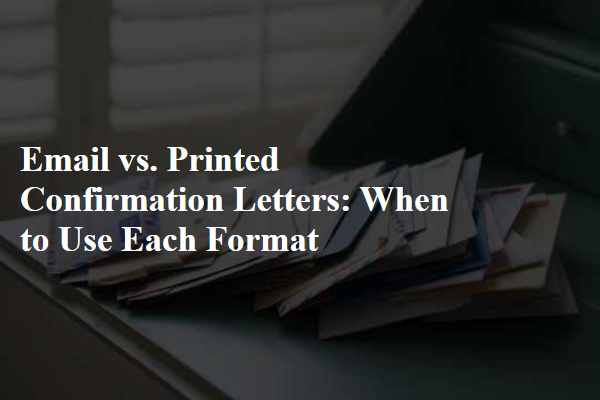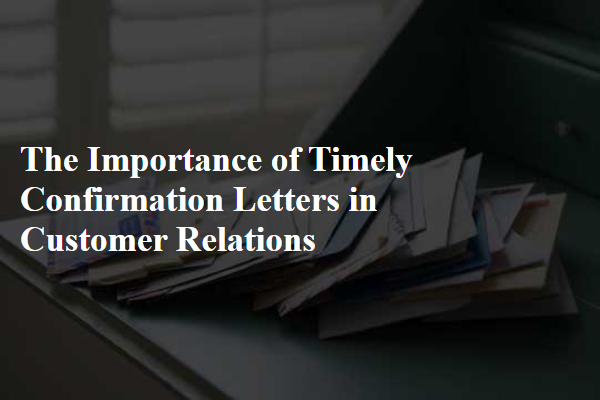
Email confirmation letters provide instant delivery and easy access, making them ideal for time-sensitive communications or when convenience is a priority. Printed confirmation letters offer a tangible, formal record, suitable for official transactions or when a physical copy is required for documentation. Choosing the appropriate format depends on the urgency, formality, and recipient preference in each specific situation.
Speed and Efficiency Considerations
Email and printed confirmation letters serve distinct purposes based on urgency, formality, and the recipient's preferences. Choosing the appropriate format enhances communication effectiveness and record-keeping.
- Email Confirmations - Ideal for quick delivery and instant verification of appointments or transactions.
- Printed Confirmation Letters - Suitable for formal communications requiring a tangible record or legal documentation.
- Recipient Considerations - Use the format that aligns with the recipient's accessibility and preferred method of correspondence.
Evaluating the context and purpose ensures the confirmation method supports clear and reliable communication.
Legal Validity and Documentation Needs
| Aspect | Email Confirmation Letters | Printed Confirmation Letters |
|---|---|---|
| Delivery Speed | Instant delivery within seconds, suitable for urgent confirmations | Takes several days due to postal service, suited for non-urgent communications |
| Formality | Informal to semi-formal, commonly used for routine transactions and reservations | Highly formal, preferred in legal, financial, or official business contexts |
| Record Keeping | Stored digitally, easy to archive and retrieve using email clients or cloud storage | Physical document, requires manual filing systems but accepted for audits and legal proof |
| Environmental Impact | Eco-friendly, reduces paper consumption and waste | Consumes paper and printing resources, contributes to environmental footprint |
| Security | Can be encrypted and password-protected, but vulnerable to hacking if not properly secured | Less prone to hacking, but can be lost, damaged, or forged |
| Cost | Low cost, no printing or postage fees | Higher cost due to paper, printing, and mailing expenses |
| Use Case Examples | Order confirmations, appointment reminders, ticket deliveries | Contract agreements, legal notices, insurance confirmations |
Audience Preferences and Demographics
Choosing between email and printed confirmation letters depends on the context, urgency, and formality of the communication. Each format offers unique advantages suited to different scenarios.
- Email Confirmations - Ideal for quick, convenient communication with immediate delivery and easy access across devices.
- Printed Confirmation Letters - Best for formal, legal, or official documentation that requires a physical record and signature.
- When to Use Each - Use email for speed and efficiency in routine transactions; choose printed letters for important agreements or compliance purposes.
Cost Implications of Each Format
Email confirmation letters provide instant delivery and are ideal for time-sensitive communications. They offer easy tracking and digital record-keeping, reducing paper usage and storage needs.
Printed confirmation letters are preferred for formal or legal documentation requiring physical signatures. They convey professionalism and are suitable when recipients may not have reliable internet access.
Security and Privacy Concerns
Choosing between email and printed confirmation letters depends on the context and urgency of communication. Each format offers unique benefits that suit different types of confirmations.
- Email Confirmation - Ideal for quick, digital communication and easy access on multiple devices.
- Printed Confirmation - Provides a physical record useful for legal purposes and formal situations.
- Usage Considerations - Emails are best for transactional updates, while printed letters are preferred for contracts and official agreements.
Environmental Impact Analysis
Email confirmation letters offer instant delivery and easy accessibility, making them ideal for urgent communications and digital records. Printed confirmation letters provide a tangible, formal record that can be essential for legal documentation or situations where electronic access is limited. Businesses should choose email for speed and convenience, while printed letters suit cases requiring physical proof or traditional presentation.
Accessibility and Ease of Retrieval
Email confirmation letters offer instant delivery and easy access, making them ideal for urgent communications and digital record-keeping. Printed confirmation letters provide a tangible, formal touch preferred in legal contexts or when recipients may have limited internet access. Choosing the appropriate format depends on the urgency, formality, and recipient preferences of the correspondence.
Customization and Branding Opportunities
Which is more effective for confirming appointments, email or printed confirmation letters? Email confirmations offer speed and convenience, allowing immediate delivery and easy access on multiple devices. Printed confirmation letters provide a tangible record, often preferred for formal occasions or when internet access is limited.
Situational Appropriateness
Email confirmation letters offer immediate delivery and easy access on multiple devices, making them ideal for time-sensitive communications. They provide a cost-effective and environmentally friendly option that supports quick updates or changes.
Printed confirmation letters create a tangible record that can be physically filed or presented, often preferred for formal or legal documentation. They convey a sense of professionalism and reliability, which is important in traditional business contexts or when recipients expect hard-copy proof.
Integration with Digital Systems
Email confirmation letters offer speed and convenience, allowing instant delivery and easy access across devices. Printed confirmation letters provide a tangible record, often preferred for formal or legal purposes where physical documentation is required.
Use email confirmations for transactions needing quick acknowledgments, such as online purchases or appointment reminders. Printed letters suit scenarios like legal agreements, contracts, or official notifications where recipients might require a signed paper copy. Choosing the right format depends on the context, recipient preferences, and the importance of retaining physical evidence.



Comments